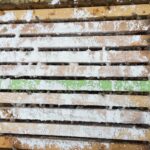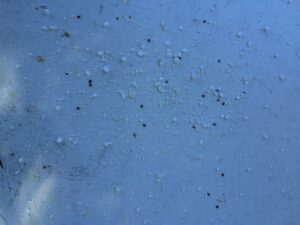These occasional warm days have probably revealed, for far too many newbees and plenty of us oldbees, that some colonies did not survive the winter. Whether you’ve just killed your first hive or your 41st, it still stings. The beekeeping learning curve is long and steep, and losing colonies is part of beekeeping, but argh! I love my bees and any loss still really hurts. Having been responsible for and then failing this bee-loved insect is a punch to the stomach.

Their lives shortened by mites feeding on them, bees fall from the frames and accumulate on the bottom board during winter. Too many died prematurely to keep the cluster warm until spring returned.
However, the world needs bees desperately, so I’ll keep getting back on the horse, keep studying and pondering, and no doubt keep continuing to learn more than I ever thought I would.
Speaking of “would”, I will quickly knock on some. Our yards have great survival rates so far, but I don’t think Mother Nature is yet through with winter in SW Michigan. Our few losses to date have primarily been from Varroa mites. There’s an excellent article and photos to figure out if that’s what killed yours here.
Hope springs eternal in spring, and in beekeepers. As I get back on the horse to try and do better, I’m again this year focusing on aggressive Varroa management. Here’s our approach and thoughts on this …
First, some givens
— All North American colonies have Varroa mites. (People often say theirs don’t because they haven’t seen any. That’s likely because they don’t know how or where to look for them, as study after study shows all North American colonies have Varroa. Most mites are under the cappings, feasting off developing bees-to-be. By the time you readily see mites on adult bees (and by you, I mean you folks with eyes younger than a half-century in age) you’re looking at a hive that has less than a year to live.

As cluster size diminished from the prematurely dying bees, the remaining bees likely froze or starved to death. There were not enough of them to move to the oh-so-close honey, and the poop stains suggest they were ill.
— Some colonies have the genetic traits to handle mites without human intervention, and the world is working on propagating bees with those traits. If you have some of those, please raise and share lots of queens.
— The experts tell us that until we can all obtain and further such genetic lines, like the Minnesota Hygienic bees or the promising Purdue ankle-biter lines, the bees lacking those genetic traits will likely need support. Unfortunately, most of the bees available commercially are not genetically equipped to deal with Varroa. See Randy Oliver’s rant (his words.)
— Add to the lack of traits to handle Varroa the pesticide/lawn chemical load hitting bees (and us), their lack of diverse and forage (because we need more parking lots?), and weather extremes. Even bees with the best Varroa-resistant genetics are under duress to stay healthy.
We’ve crossed our fingers in hopes that our bees are genetically capable of handling mites on their own. But, we are their caretakers, and have made a plan to help if need … bee. And, I love to make plans because God needs a good laugh.
Our plan
1) Monitor all colonies all season long, minimally monthly, starting in spring … not like in July or August like, um, happened in some (all previous) years. We monitor using a powdered sugar roll, as developed by the University of Minnesota. They have a great poster showing how this is done at this site.
Please note, the powdered sugar roll is different than using powdered sugar as a mite treatment. The roll gives an indication of whether you have a problem requiring treatment. Powdered sugar dusting is a type of treatment.
2) Practice rigorous integrated pest management (IPM) all season long. This guide describes the various options. and their effectiveness.

A drone trapping frame (lime green) near the brood nest. A powdered sugar bath treatment was just applied.
Our IPM includes breaks in the brood cycle by splitting hives, screened bottom boards, routine powder sugar dusting, and drone trapping. Google any of those for comprehensive information on how to do them. The only year we’ve had 100% overwintering success is when we rigorously dusted with powdered sugar and trapped drones. (Drone trapping requires disciplined recording of dates, and room in the freezer which is fine—someone has to eat all the ice cream we bought on sale; I’ll do it on behalf of bees.)
3) We will treat chemically whenever a colony hits the treatment threshold. That threshold varies by season, as detailed in the guide previously mentioned.
What we treat with chemically will vary depending upon whether the colony is producing honey for human consumption, where we are in the season, and any previous treatments that colony may have had (want to alter agents to help avoid building resistance.) We will not treat with the “hard chemicals,” but rather will use oxalic acid (found naturally in the hive, and in carrots, among other things), and a hop-based product (ditto, except found in beer among other things), a formic acid-based treatment (formic is found in bee and ant stings, oddly enough) and / or a thymol-based treatment. There are frequency of use and temperature considerations for each, as well as safety challenges, so again, we defer to the excellent guide mentioned previously, as well as the label of each agent.
In summary
For years I was a chemical-free beekeeper, but I’ve never been treatment-free. Please realize that breaking the brood cycle, or using a powdered sugar dust, etc. is a form of treatment. I’ve only recently hopped on the chemically-treat-if-necessary bandwagon for colonies that prove to me they can’t handle the mites without our help. Unfortunately for a handful of our colonies, I didn’t fully grasp what they were telling me and their pretty painted hives became colorful gravesites in the past few months. Did I mention that the beekeeping learning curve is long and steep?
Deciding to chemically intervene when necessary isn’t a decision I’ve arrived at without much deliberation. Having killed plenty of bees on my watch, it is time to try something different, so I’ve researched and listened to what the experts advise.
While IPM and “soft” chemical treatments aren’t without challenges, replacing bees year after year is costly both in terms of dollars, and also because of the pressure it puts on bee suppliers to meet the demand (sometimes with compromised stock that is likely to fail no matter what I do.) And, not practicing IPM, and then not monitoring to see if it is working, and then just wishing the best for a colony that’s starting its march toward a cruel death is too painful for this lover of bees.
And way too painful for them.

